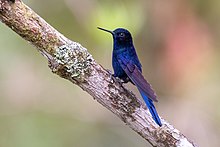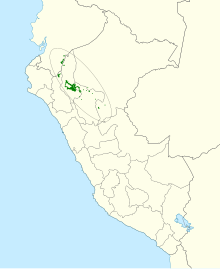| Royal sunangel | |
|---|---|

| |
| Conservation status | |
 Near Threatened (IUCN 3.1) | |
| CITES Appendix II (CITES) | |
| Scientific classification | |
| Domain: | Eukaryota |
| Kingdom: | Animalia |
| Phylum: | Chordata |
| Class: | Aves |
| Clade: | Strisores |
| Order: | Apodiformes |
| Family: | Trochilidae |
| Genus: | Heliangelus |
| Species: | H. regalis |
| Binomial name | |
| Heliangelus regalis Fitzpatrick, Willard & Terborgh, 1979 | |

| |
The royal sunangel (Heliangelus regalis) is an endangered species of hummingbird in the "coquettes", tribe Lesbiini of subfamily Lesbiinae. It is found in Ecuador and Peru.
Taxonomy and systematics
The royal sunangel was originally described in 1979 as monotypic. In 2011 a second subspecies, H. r. johnsoni, was described and was accepted by major taxonomic systems.
Description
The royal sunangel is 10 to 12 cm (3.9 to 4.7 in) long and weighs 3.4 to 4.5 g (0.12 to 0.16 oz). Its black bill is short and straight. Both subspecies are strongly sexually dichromatic. The adult males are unique among genus Heliangelus: Their bodies are entirely dark blue. The nominate's plumage is slightly shiny, with significant iridescence only on its forecrown (just above the bill). H. r. johnsoni is intensely iridescent all over and especially so on the crown, throat, and upper breast. The male nominate's tail is dark metallic violet-purple and that of johnsoni is metallic indigo. Both males' tails are deeply forked.
Adult females of the two subspecies are similar to those of the rest of genus Heliangelus and differ only slightly between them. They are dark green above and rich cinnamon with bronzy green discs below. A buffy breastband separates the throat and chest. Their tails are not as deeply forked as those of the males. The nominate female's tail is blue-black and that of johnsoni is metallic indigo like that of the male. Juveniles are like the females but with gray spots instead of green on the throat. The amount of blue in males increases with age and typically the gorget is the first area to achieve it.
Distribution and habitat
The nominate subspecies of royal sunangel is mostly found in the Cordillera del Cóndor of Peru's Cajamarca and Amazonas departments, and also on the east slope of the Andes in Peru's departments of San Martín and Loreto. It was first documented in extreme southeastern Ecuador's Zamora-Chinchipe Province in 2008. H. r. johnsoni is found only in the Cordillera Azul of northern Peru.
The royal sunangel inhabits a few specialized landscapes. It is most numerous in "elfin scrub", a rather dry grassland habitat with mossy stunted forest and small bushes that forms the transition between dry savannah and humid elfin forest. It is also found in steep wooded ravines, and in Ecuador is most numerous on sandstone ridges with páramo-like vegetation but also in medium-elevation forest. The species is most abundant between 1,500 and 2,200 m (4,900 and 7,200 ft) of elevation. It has been documented as low as 1,250 m (4,100 ft) and there are sight records between 550 and 700 m (1,800 and 2,300 ft) in Peru.
Behavior
Movement
The royal sunangel's movements have not been documented but seasonal altitudinal changes are likely. Outside the breeding season it seems that females tend to occur at lower elevations than males.
Feeding
The royal sunangel feeds on nectar and insects. Several flowering plants, shrubs, and small trees have been identified as nectar sources. Males are highly territorial at flowering bushes. Both sexes often feed by perching on a flower rather than hovering, and they have been observed "robbing" nectar from holes pierced by other birds. They capture insects by hawking from a perch and by gleaning from vegetation.
Breeding
The few records suggest that the royal sunangel's breeding season is from July to September. The clutch of two white eggs is incubated by the female. Nothing else is known about the species' breeding phenology and no nest has been described.
|
Songs and calls Listen to royal sunangel on xeno-canto |
Vocalization
The royal sunangel has a wide variety of vocalizations. During aerial displays males give "a series of emphatic 'tseep' notes". Two agonistic males "uttered an endless, thin, high-pitched jumble of 'jijijit’jijit’jijit’jijiji…' notes". Calls given while feeding are "a repeated short dry and emphatis 'tsik' or 'tsawk'". One male gave "a sharp, high-pitched, fast 'chichúp chúp!'" and a female "a thin, high-pitched 'tziíp!'".
Status
The IUCN assesses the royal sunangel as near threatened. It has a highly fragmented range, with a documented presence at fewer than 10 locations, and its specialized habitat is under threat from cultivation and deforestation.
References
- ^ BirdLife International (2022). "Royal Sunangel Heliangelus regalis". IUCN Red List of Threatened Species. 2022: e.T22687901A210187058. Retrieved 23 July 2022.
- "Appendices | CITES". cites.org. Retrieved 2022-01-14.
- ^ Fitzpatrick, J.W.; Willard, D.E.; Terborgh, J.W. (1979). "A new species of hummingbird from Peru". Wilson Bulletin. 91: 177–186.
- ^ Gill, F.; Donsker, D.; Rasmussen, P. (July 2021). "IOC World Bird List (v 12.1)". doi:10.14344/IOC.ML.11.2. Retrieved January 15, 2022.
- ^ HBW and BirdLife International (2020) Handbook of the Birds of the World and BirdLife International digital checklist of the birds of the world Version 5. Available at: http://datazone.birdlife.org/userfiles/file/Species/Taxonomy/HBW-BirdLife_Checklist_v5_Dec20.zip retrieved May 27, 2021
- Remsen, J. V., Jr., J. I. Areta, E. Bonaccorso, S. Claramunt, A. Jaramillo, D. F. Lane, J. F. Pacheco, M. B. Robbins, F. G. Stiles, and K. J. Zimmer. Version 24 August 2021. Species Lists of Birds for South American Countries and Territories. https://www.museum.lsu.edu/~Remsen/SACCCountryLists.htm retrieved August 24, 2021
- Graves, G.R.; Lane, D.F.; O'Neill, J.P; Valqui, T. (2011). "A distinctive new subspecies of the Royal Sunangel (Aves: Trochiliformes; Heliangelus regalis) from the Cordillera Azul, northern Peru". Zootaxa. 3002: 52–58. doi:10.11646/zootaxa.3002.1.5.
- Clements, J. F., T. S. Schulenberg, M. J. Iliff, S. M. Billerman, T. A. Fredericks, J. A. Gerbracht, D. Lepage, B. L. Sullivan, and C. L. Wood. 2021. The eBird/Clements checklist of Birds of the World: v2021. Downloaded from https://www.birds.cornell.edu/clementschecklist/download/ Retrieved August 25, 2021
- ^ Heynen, I., P. F. D. Boesman, and G. M. Kirwan (2020). Royal Sunangel (Heliangelus regalis), version 1.0. In Birds of the World (J. del Hoyo, A. Elliott, J. Sargatal, D. A. Christie, and E. de Juana, Editors). Cornell Lab of Ornithology, Ithaca, NY, USA. https://doi.org/10.2173/bow.roysun1.01 retrieved January 22, 2022
- Krabbe, N.; Ahlman, F.L. (2008). "Royal Sunangel Heliangelus regalis at Yankuam Lodge, Ecuador". Cotinga. 31: 31.
